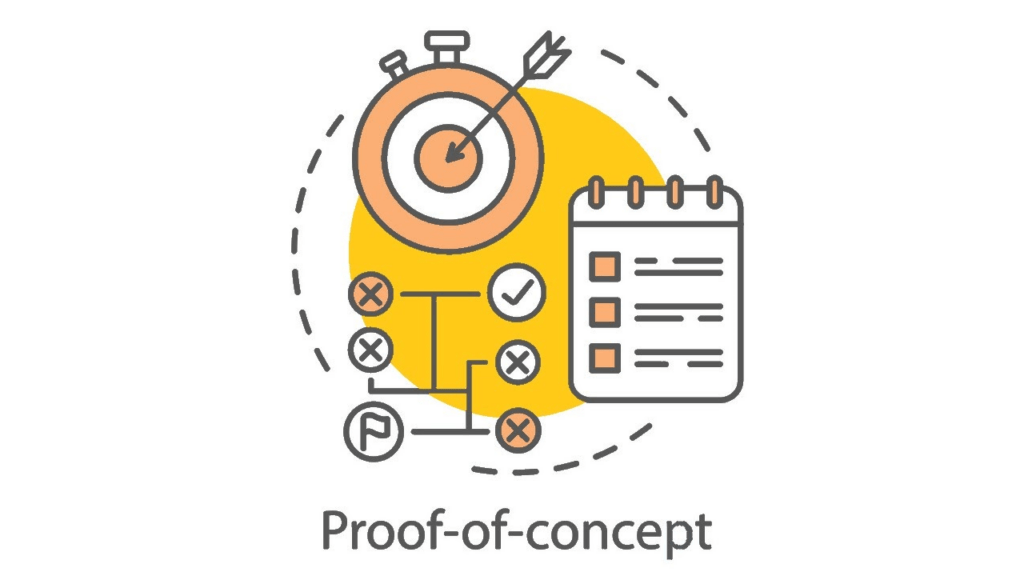Are you curious about how software development companies create new products and features? Well, they often start with a POC or proof of concept. A POC is a prototype or model of a product for verifying that a concept is feasible and can become a working product. In the world of software, POCs are popular for testing new ideas and functionalities before investing time and resources in development. In this article, we will explore the concept of POC in software and how it can benefit companies in the development process. We’ll cover its definition, why it is important, and its usages in the software industry. So, let’s dive in!
An Overview on POC
When it comes to developing new software or updating existing systems, businesses often need to test out ideas and ensure they’re viable before investing significant time and resources into development. This is where a proof of concept (POC) in software comes in.
The Definition of POC
POC or proof of concept is a critical part of software development that helps validate a product idea before investing significant resources. A POC is a small-scale version of the final product that demonstrates the core features and functionality. It serves as evidence that the proposed solution is feasible, practical, and addresses the business problem.
A POC is typically common in the early stages of the software development lifecycle to evaluate the potential of a concept or idea. It helps identify potential risks, technical challenges, and limitations that could impact the project’s success. POCs demonstrate a specific aspect of the software, such as a new feature, a new technology, or a new integration.

In essence, a POC is an experimental model of the final product that aims to prove or disprove a hypothesis. A POC can come from minimal resources and can assist in testing the market’s response to the product idea. The purpose of a POC is to gain insight into the project’s viability, understand user needs, and determine the best approach for implementing the solution.
Key Elements of a POC
When developing a POC for a software project, there are several key elements to consider.
- A POC should have clear objectives and goals compatible with the overall project goals. This helps to ensure that the POC is relevant and useful for the project.
- A POC should be able to test the feasibility of the solution. This means that it should be possible to implement the proposed solution using the technology and resources available.
- The scope of a POC should limit to a specific set of features or functionalities. This allows for a focused approach to testing and validation.
- The POC should be designed to test with real-world data or sample data. Additionally, it should also ensure that the proposed solution will be able to handle real-world use cases.
- It should be able to test the performance of the proposed solution, to ensure that it meets the performance benchmarks.
- The POC should also test the user experience of the proposed solution, to ensure that it meets the needs of the end-users.
- A POC should be well-documented, with clear and concise documentation. The latter should outline the objectives, scope, and methodology used in the testing process.
By considering these key elements when developing a POC for a software project, developers can ensure that the POC is relevant, feasible, and effective in testing the proposed solution.
Recommended reading: What Is Data Structure and Their Applications?
Advantages of Using POC
POC is a crucial part of software development, and there are several advantages to using it. Here are some of the benefits of using POC in software:
- Mitigates risks: POC allows developers to test the feasibility of an idea without committing to it fully. By creating a prototype, developers can identify and mitigate potential risks early in the development process.
- Saves time and money: With a POC, developers can identify and fix potential problems early in the development process, saving time and money in the long run. By testing and validating the idea before committing to full-scale development, POC ensures that resources are used efficiently.
- Enhances collaboration: POC helps to promote collaboration among team members, stakeholders, and customers. Through creating a tangible product that everyone can see and interact with, POC fosters discussions and feedback that can help refine the idea and improve the final product.
- Demonstrates value: POC can be used to demonstrate the value of a product to potential investors or customers. By providing a working prototype, stakeholders can see the product in action and gain a better understanding of its potential value.
- Improves decision-making: By providing tangible evidence of an idea’s potential, POC can also help stakeholders make informed decisions. Using a POC, stakeholders can make better-informed decisions about whether or not to proceed with full-scale development.
In summary, POC is an essential tool for software development. It helps mitigate risks, saves time and money, promotes collaboration, demonstrates value, and improves decision-making.
The Role of POC in Software Development
In the world of software development, proof of concept (POC) plays a crucial role. It helps developers validate their ideas, test their assumptions, and demonstrate the feasibility of their concepts. All of it should come before investing significant resources into full-scale development. In this section, we will explore the role of POC in software development and how it can help businesses.
How POCs help in software development
Proof of concept (POC) is a valuable tool in software development. POCs help developers to quickly identify potential issues with a software product before a significant investment. It also enables developers to identify whether the proposed solution is technically feasible and whether it meets the needs of the customer.
POCs help to reduce the risk associated with software development. It allows stakeholders to identify any potential issues or limitations of a project before committing to full-scale development. This approach also saves time and money. This is because developers can avoid investing in a project that ultimately fails to meet the requirements of the client.
POCs allow developers to test the viability of a project and to identify areas of improvement. This process also enables developers to get feedback from stakeholders. This helps to ensure that the final product meets the client’s expectations. POCs can also help developers to identify the most effective way to approach a project.
By identifying issues early on, POCs enable developers to create a more stable and reliable software product. It can lead to higher user satisfaction and reduce the number of bugs and issues before release.
In summary, POCs are an essential part of software development. They help to reduce risk, save time and money, identify areas of improvement. They also ensure that the final product meets the client’s expectations. By using POCs, developers can create a more reliable and effective software product.
Recommended reading: What Is Software Architecture? Benefits, Characteristics and Examples
Importance of POCs in reducing development costs
POCs are an essential part of software development. They are used to test the feasibility of a project or idea before the development process begins. POCs help reduce the overall cost of development by minimizing the risk of costly mistakes.

POCs provide developers with the opportunity to test out the project concept in a smaller, more controlled environment. This allows them to identify any potential problems and make changes early on in the development process, avoiding costly mistakes and delays in the future. Additionally, POCs can help developers to identify the best technologies and approaches to use, in the most cost-effective way.
POCs can also be used to identify any potential issues with the project before it goes live. This means that developers can make any necessary changes and ensure that the project is up to standards. This reduces the risk of costly problems occurring later on in the development process, saving time and money.
Overall, POCs are an invaluable tool for software developers. They help to reduce development costs by minimizing the risk of costly mistakes and ensuring that the project is viable. Additionally, they can help identify any potential issues before the project goes live, saving developers time and money in the long run.
Examples of POCs in software development
In software development, POCs have been used extensively to test the feasibility of new ideas, technologies, or features. For instance, a software company looking to develop a new app may use a POC to determine whether the idea is worth investing in. Similarly, a team developing a new software feature may use a POC to evaluate its performance and to ensure that it meets the requirements of the end-users.
One notable example of the use of POCs in software development is the development of the popular messaging app, Slack. When the founders of Slack began working on the app, they used a POC to test the basic functionality of the platform. This POC helped them to identify potential issues and to refine their ideas before moving on to full-scale development. As a result, Slack was able to launch as a highly polished and functional app that quickly became popular among users.
Another example of the use of POCs in software development is in the development of virtual reality (VR) and augmented reality (AR) applications. These types of apps require significant investment and development time, and using a POC to test the technology and user experience can help companies to determine whether the investment is worth it. For instance, a company developing a VR game may use a POC to test the game’s mechanics and user interface, identify potential issues, and refine the overall experience before moving on to full-scale development.
Overall, POCs have proven to be a valuable tool in software development, allowing teams to test new ideas, technologies, and features before investing significant time and resources. By using a POC to evaluate a concept, software developers can refine their ideas, identify potential issues, and ensure that the final product meets the needs of end-users.
Recommended reading: What Does a Business Analyst Do and How to Become?
The Process of Creating a POC
Creating a POC is an essential part of the software development process. It allows developers to test their ideas and concepts and determine whether they are feasible or not. However, creating a POC is not a straightforward task, and it requires careful planning and execution. In this section, we will discuss the process of creating a POC and the important steps that developers should follow to ensure the success of their project. By the end of this section, you will have a clear understanding of how to create a POC and the benefits it can bring to your software development projects.
Steps to create a POC
Creating a proof of concept (POC) in software can be a complex process. It is important to understand the purpose of a POC and the steps necessary to achieve the desired outcome. A POC should be used to demonstrate the feasibility of a software solution and prove that the concept is viable. To create a successful POC, it is essential to define the scope of the project, identify the stakeholders, and develop a timeline. It is also important to set realistic goals and objectives, and to create a plan of action.
When planning the POC, it is important to consider the resources available and the budget. The team should also consider the technical requirements of the project, such as software and hardware requirements. Additionally, the team should consider the user experience and how the POC will be tested. Once the scope and timeline have been established, the team should create a prototype and develop the necessary code.

Once the POC is complete, the team should evaluate the results and document the process. This will help the team to determine whether the POC was successful and to identify any areas for improvement. The team should also consider the feedback from stakeholders and users, and use this feedback to refine the product.
Creating a successful POC requires careful planning and execution. It is important to understand the purpose of the POC and to develop a plan of action. Additionally, the team should consider the resources available, the technical requirements, and the user experience. Finally, the team should evaluate the results and document the process. By following these steps, the team can create a successful POC in software.
Best practices for creating a POC
A POC is a demonstration of the feasibility of a project, and it is essential for assessing the risks and benefits of the project. To ensure that the POC is successful, there are certain best practices to follow.
Firstly, it is important to have a clear goal and objectives. You should determine the project’s purpose and its expected outcome. This will help you create a plan to achieve the objectives. Secondly, you should identify the stakeholders and their needs. Knowing who the stakeholders are and what they need from the POC will help you create a plan to meet their needs.
Thirdly, you should also determine the resources needed for the project. This includes the budget, the time frame, and the personnel. Once the resources are identified, you can create a timeline for the project. Fourthly, you should create a plan to test the POC. This includes testing the design, the functionality, and the scalability of the project. Finally, you should document the results of the POC. This will help you evaluate the results and make decisions about the project.
With these best practices, you can ensure that your POC in software is successful. This will help you assess the risks and benefits of the project and make informed decisions.
Common mistakes to avoid when creating a POC
When creating a POC, it is important to avoid certain common mistakes that can lead to an unsuccessful outcome. One of the biggest mistakes is failing to define clear goals and objectives for the POC. This can result in a lack of direction and focus, which can lead to wasted time and resources.
Another mistake is trying to include too many features or functionalities in the POC. This can lead to scope creep, making it harder to develop and test the POC within a reasonable timeframe. It’s important to keep the POC simple and focused on the core objectives.
Another common mistake is failing to involve all relevant stakeholders in the POC development process. This can result in a POC that does not meet the needs of all stakeholders, leading to resistance and potential project failure.
Additionally, it is important to use realistic data and scenarios when developing the POC. Using unrealistic or inaccurate data can result in a POC that does not accurately represent real-world scenarios, making it difficult to determine if the POC is successful or not.
Lastly, it’s important to have a plan in place for evaluating the success of the POC. Without clear criteria for success, it can be difficult to determine if the POC was successful or not, leading to uncertainty and potentially wasted time and resources.
By avoiding these common mistakes, the process of creating a POC can be smoother and more effective, leading to a successful outcome.
FURTHER READING: |
1. How to Improve Developer Productivity for Long Term? |
2. Are Cloud-Native Applications Safe Enough for Businesses? |
3. Web Application Security: The Best Guide and Its Practices |
Conclusion
In conclusion, POCs play a crucial role in software development by providing a quick and cost-effective way to test and validate ideas before investing significant resources into a full-fledged project. However, creating a successful POC requires careful planning, attention to detail, and a focus on the project’s goals and objectives.
When creating a POC, it’s essential to avoid common mistakes such as over-engineering, ignoring user feedback, and failing to consider scalability and maintainability. By avoiding these mistakes and following a structured process, you can increase the chances of developing a successful POC that will pave the way for a successful software project.
If you’re looking for a reliable software development firm to help you create a POC or develop a full-fledged software solution, consider Designveloper. As a leading software development firm in Vietnam, Designveloper has a team of experienced developers and a proven track record of delivering high-quality software solutions to clients worldwide. Contact Designveloper today to learn more about their services and how they can help you turn your ideas into reality.























